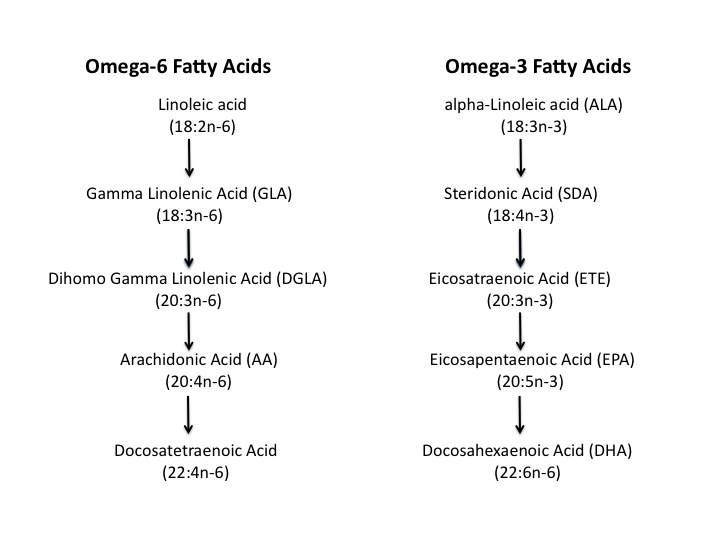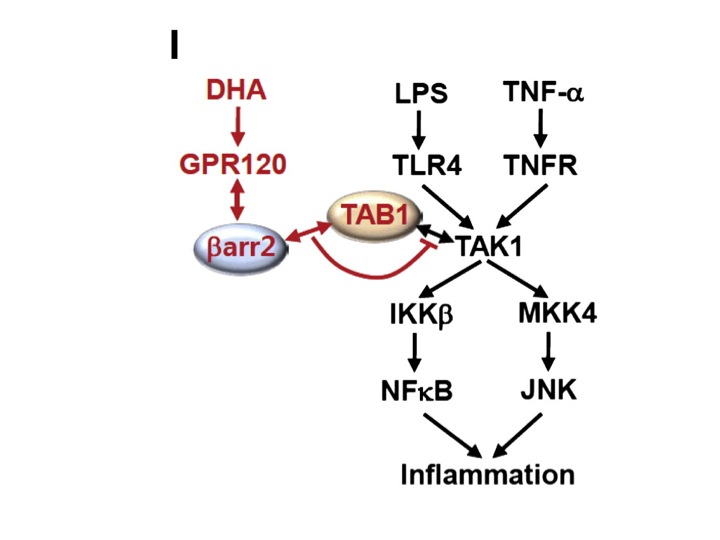I have a confession.
I’m a pusher.
I tell anyone who will listen that they should take omega-3 fatty acids.
- Got elbow pain? Take some omega-3s.
- Memory loss? Write a note to yourself to take some omega-3s.
- Worried about heart disease? Take omega-3s.
- Diabetic? Take omega-3s.
- Got asthma, psoriasis, dyslexia, depression, rheumatoid arthritis, high blood pressure or are overweight? Yeah, you know what to do.
You must be scratching your head. How can one nutrient do so much? I’m with you: Any time I hear how X, Y or Z drug, supplement, or newest infomercial cleaner can do nearly everything I immediately write it off as a scam.
So how can omega-3 fatty acids improve all these conditions?
Omega-3s: nutritional powerhouses
Omega-3s and inflammation
Omega-3 fatty acids have amazing anti-inflammatory properties.
Now, when I say “inflammation”, you probably think of the puffy red I’ve dropped something on my toes kind of inflammation. Sure, omega-3 fatty acids do help with very obvious inflammation, but they do so much more.
You see, joint pain, heart disease and autoimmune diseases (asthma, psoriasis, rheumatoid arthritis, etc.) are all inflammations too — chronic (aka long-term) rather than acute (aka short-term) inflammation.
While acute inflammation is good for us, and an important part of the healing process, chronic inflammation is not. Chronic inflammation is like the body’s “broken record”: It gets stuck in a rut of being inflamed, which then causes other problems like the body’s immune system attacking itself.
Omega-3s make us smarter
Omega-3 fatty acids are also important for brain cells because omega-3s provide energy and make up membranes of the cells. No surprise that healthier and happier brain cells means better brain development and function, including memory.
One theory of human development suggests that our ancestors ate a lot of seafood high in omega-3 fatty acids, particularly DHA (docosahexanoic acid), and that is why we became smarter than our primate cousins, then started living in condos with iPods and cellphones. (Wait, was that actually smarter?)
Omega-3s make us leaner
Omega-3 fatty acids can improve insulin sensitivity and make our bodies better at using stored body fat for energy, which both add up to a leaner physique.
Omega-3 fatty acids: A family of fat
Before I get into how omega-3 fatty acids can do everything but save your soul (you may need a different type of oil for that), I’ll give you the Coles Notes on fats and fatty acid biochemistry.
Fat: You’ve cut it off your steak or poked some on your belly, but what is it? Biochemistry folks like making themselves sound smart so they call fats “lipids”.
Whatever the name, they can’t dissolve in water. Go ahead, give it a try: Put some oil into a glass of water and stir. I’ll wait.
Well you didn’t try very hard. How about trying a blender? Success! Or so you think.
Even though you can make it look like the has oil dissolved, like in salad dressings, what you’ve done is make the oil droplets really really small so you can’t see them as big oil droplets. But if you look under a microscope they’re still there. (This is known as an emulsion — and it’s how you make real mayonnaise, or perhaps Green Goddess dressing.)
Anyway, there are a few lipid types in food; triglycerides, phospholipids, and sterols. For today we’ll just look at triglycerides.
Triglycerides
Think of a triglyceride molecule as a bookshelf. Just as your bookcase has a frame and shelves, triglycerides have a frame (aka a backbone) called glycerol and three (“tri”) shelves called fatty acids. The three fatty acid “shelves” attach to glycerol to make a triglyceride molecule.
Even though glycerol is the same in every triglyceride molecule, the fatty acids can be short or long and they can be more or less saturated (more on that in a bit). If you think of our bookcase analogy you can have shelves that only go a quarter, halfway, or across the entire bookcase and you can have shelves that can be thicker or thinner, which can hold more or less weight.
Another analogy that might help is thinking of biochemistry in terms of Lego bricks. You have different molecules (Lego bricks) that stick and unstick to each other depending on different things, including what your body needs at any given time. A glycerol brick and 3 fatty acid bricks make a triglyceride molecule instead of, say, a space station.
Long and short fatty acids
Fatty acids range from fewer than 6 carbons to more than 22 carbons long. Ever-so-clever names for fatty acids of different length are: short-chain, medium-chain, long-chain and very-long chain… Just like when you were little and asked for the short, medium, long or the super-long Lego brick.
Fatty acid saturation
Besides how long a fatty acid is, it can be more or less saturated. Now, if I push you into a swimming pool your clothes will be saturated — with water. With fatty acids they get saturated with hydrogen.
To understand saturation, it helps to understand how hydrogen bonds to fatty acid molecules.
Warning! Chemistry 101 ahead!
If you remember your high school chemistry, you’ll remember double bonds.Carbon atoms have 4 binding sites, like a trailer hitch where you can hook something up. Fatty acids are mostly chains of carbons. Each carbon is bound to its neighbouring carbon on either side, as well as to hydrogen. In saturated fatty acids, the other 2 binding sites (where there aren’t carbons) will bind to hydrogen.
When a carbon atom “loses” a hydrogen atom, since it has an extra trailer hitch free, it will create a double bond with the neighboring carbon atom that also is missing a hydrogen atom. Think of bonds as rubber resistance bands: Just like bands, the more you have the stronger they are.
Fatty acids with fewer hydrogens have more double bonds and are less saturated.
- Monounsaturated fatty acids have 2 fewer hydrogens and 1 double bond.
- Polyunsaturated fatty acids have a few more missing hydrogens (usually between 4 and 6).
The location of these double bonds along the fatty acid chain is important.
If the last double bond is the 6th carbon from the end, it is an omega-6 fatty acid (omega being the last letter of the Greek alphabet). Omega-3 fatty acids have the last double bond 3rd from the end carbon.
Essential fatty acids
Our bodies can make most of the fatty acids we need, but we can’t make two types of essential fatty acids: linoleic acid (LA) and alpha-linoleic acid (ALA).
Linoleic acid is a omega-6 fatty acid (18 carbons, 2 double bonds, last one 6 from the end -18:2n-6) while alpha linoleic acid is an omega-3 fatty acid (18:3n-3).
If you take a look at figure 1, you can see how these two fatty acids can be converted to other fatty acids, including one that we’ll look at today — DHA.

For more on fatty acids, see All About Healthy Fats and All About Fish Oil.
Research question
This week’s review looks at how the omega-3 fatty acids EPA and DHA are anti-inflammatory and can sensitize cells to insulin, thus possibly improving and treating diabetes.
Oh DY, et al. GPR120 is an omega-3 fatty acid receptor mediating potent anti-inflammatory and insulin-sensitizing effects. Cell. 2010 Sep 3;142(5):687-98.
Methods
What a knockout
The easiest way to figure out how something works is to take away something that you think is crucial. For example, maybe you’re not too sure how a car works, but you think spark plugs are important and maybe the seat covers.
What to do? You take out the spark plugs. What happens? Your car doesn’t start. Therefore you conclude that you need spark plugs to start your car. After putting the spark plugs back in, you take out the seat covers. What happens? Your car starts and everything seems to work perfectly fine, therefore seat covers are not important in order for your car to run.
Usually these “how does this work” experiments end up using mice, because you can genetically modify mice by taking something away that you think is important. When you remove a gene, it’s called a knock-out mouse because you’ve knocked out the gene. If you add a gene, it’s called a transgenic mouse.
In this study, researchers knocked out a receptor gene called GPR120 (from the G protein-coupled receptor family). Since other similar receptors sense other fatty acids, researchers thought GPR120 might be an omega-3 sensor and GPR120 is in fat tissue and immune cells (macrophages), so location, location, location.
Because both fat and macrophages are involved in inflammation, and omega-3 fatty acids are good at stopping inflammation, maybe GPR120 is the key to the process. If GPR120 is really important for omega-3 fatty acids’ anti-inflammatory abilities, then getting rid of it would stop omega-3 fatty acids from working.
Thus, researchers had their spark plugs and seat covers: Half the mice were normal and had GPR120. Half the mice were knockouts with no GPR120.
Researchers hypothesized that omega-3 fatty acids would help improve inflammation and insulin sensitivity in the normal mice, but would do nothing for the mice without GPR120 if GPR120 was the only way omega-3 fatty acids worked.
High fat diet
Researchers fed the mice a general high-fat diet for 12 weeks and then they switched to a similarly high-fat diet — except the second “high fat” diet involved high omega-3 fatty acids (60% fat with 27% coming from menhaden fish oil made up of 9% DHA and 16% EPA). Then they looked at what happened to the mice, focusing especially on immune cells (macrophages).
Results & conclusion
First thing they found was omega-3 fatty acids caused more GPR120 to be made in fat and in proinflammatory macrophages, and produced less inflammation (using specific proteins involved in inflammation as indicators).
The intial 12 week diet made the mice obese with lots of inflammation and insulin resistance, just like humans.
- Mice with GPR120 (normal mice) ate the omega-3 fatty acids ended up with less inflammation and less insulin resistance.
- Mice without GPR120 (knockout mice) still had inflammation and were still insulin resistant.
That means that omega-3 fatty acids work through GPR120.
For the sake of clarity, figure 2 is a simplified schematic of what the researchers think is going on. In reality there are way more proteins and arrows.

Basically, the omega-3 fatty acid DHA attaches to GPR120 and triggers a domino effect that blocks inflammation signals (from TNF-alpha and LPS proteins). Usually an anti-inflammatory blocks one line of dominos or a small subsection, but not all.
So, DHA is like a giant roadblock, whereas other anti-inflammatory agents are more like small obstacles in the road.
 Other anti-inflammatories |
 DHA |
Bottom line
Omega-3 fatty acids, specifically DHA and EPA, work because they block inflammation pathways in the cell. They block not one but multiple pathways. Immune cells (macrophages) seem to be particularly sensitive to omega-3’s anti-inflammatory effects.
Thus, I am vindicated in my love for omega-3s.
If you want to learn more, check out the video on Cell’s site.
Learn more
Want to get in the best shape of your life, and stay that way for good? Check out the following 5-day body transformation courses.
The best part? They're totally free.
To check out the free courses, just click one of the links below.





Share